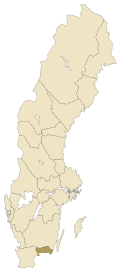Blekinge
| Blekinge | ||
|---|---|---|
|
||
 |
||
| Country | Sweden | |
| Land | Götaland | |
| County | Blekinge County | |
| Area | ||
| • Total | 3,055 km2 (1,180 sq mi) | |
| Population (Dec. 2012) | ||
| • Total | 152,315 | |
| • Density | 50/km2 (130/sq mi) | |
| Ethnicity | ||
| • Language | Swedish | |
| Culture | ||
| • Flower | Oak and mullein | |
| • Animal | Lucanus cervus | |
| • Bird | Nuthatch | |
| • Fish | Cod | |
| Time zone | CET (UTC+1) | |
| • Summer (DST) | CEST (UTC+2) | |
| Area codes | 0454–0457 | |
Blekinge (Swedish pronunciation: [ˈbleːˈkɪŋə]) is one of the traditional provinces of Sweden (landskap), situated in the south of the country. It borders Småland, Scania and the Baltic Sea. It is the country's second-smallest province by area (only Öland is smaller), and the smallest province located on the mainland.
The name "Blekinge" comes from the adjective bleke, which corresponds to the nautical term for "dead calm".
The historical provinces of Sweden serve no administrative function. Blekinge is, however, the only province, besides Gotland, which covers exactly the same area as the administrative county, which is Blekinge County.
Blekinge was granted its current arms at the funeral of Charles X Gustav of Sweden in 1660, based on a seal from the 15th century. Symbolically the three crowns from the Coat of arms of Sweden had been placed on the trunk of the tree to mark the change in status of the former Danish province, that now belonged to Sweden. The arms is represented with a ducal coronet. Blazon: "Azure, an Oak Tree eradicated Or ensigned with three Crowns palewise of the same."
Blekinge has a scenic archipelago and is sometimes called the "Garden of Sweden".
Blekinge became part of the kingdom of Denmark at some point in the early 11th century – most likely 1026. Its status before then is unknown. It then remained a Danish province for over 600 years, and together with the provinces of Skåne and Halland, it made up the eastern part of the Danish kingdom where Scanian Law prevailed. As a border province Blekinge was often raided and looted by Swedish troops during Danish–Swedish wars. In 1658 it was ceded to Sweden according to the Treaty of Roskilde and has remained Swedish ever since.
...
Wikipedia

